|
Battle of Cool Spring
Other Names: Cool Springs, Snickers Ferry (Snicker's Ferry),
Parker's Ford (Parkers Ford), Castleman’s Ferry (Castleman Ferry)
Location: Clarke County, Virginia
Campaign: Early’s Raid and Operations against the B&O
Railroad (June-August 1864); 1864 Shenandoah Valley Campaigns
Date(s): July 17-18, 1864
Principal Commanders: Maj. Gen. Horatio Wright [US]; Lt. Gen.
Jubal A. Early [CS]
Forces Engaged: 13,000 total (US 5,000; CS 8,000)
Estimated Casualties: 819 total (US 422; CS 397)
Result(s): Confederate victory
| Civil War Battle of Cool Spring Battlefield Map |
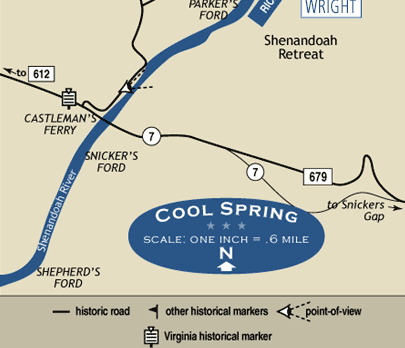
|
| Courtesy Official Virginia Civil War Battlefield Guide |
Description: A Union column, consisting of the VI Corps and elements
of the XIX Corps under Maj. Gen. Horatio Wright, pursued Early’s army as it withdrew from the environs of Washington,
D.C. Wright’s force was joined by elements of Crook’s command, which had accompanied Hunter during his retreat
through West Virginia.
On July 17, the Union cavalry passed through Snickers Gap and attempted
to force passage of the Shenandoah River at Snickers Ford (Castleman’s Ferry).
On the morning of July 18, the vanguard of the Union infantry moved
through Snickers Gap. Col. Joseph Thoburn (of Crook’s command) led his division downstream to cross the river at Judge
Richard Parker’s Ford. Early’s three nearby infantry divisions moved to defend the fords. In the afternoon, Rodes’s
division attacked and shattered Thoburn’s right flank on the Cool Spring plantation. Thoburn made a stand behind a stone
wall at the river’s edge and beat off three attacks until darkness enabled him to withdraw. Union pursuit of Early was
delayed several days.
| Battle of Cool Spring, Virginia, Map |
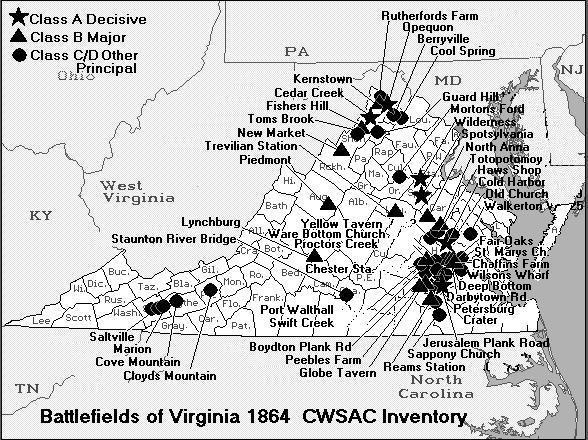
|
| Civil War Cool Spring Battlefield Map |
Setting the Stage: Robert E. Lee was concerned about
Hunter's advances in the Valley during 1864, which threatened critical railroad lines and provisions for the Virginia-based
Confederate forces. He sent Jubal Early's corps to sweep Union forces from the Valley and, if possible, to menace Washington, D.C.,
hoping to compel Grant to dilute his forces against Lee around Petersburg, Virginia.
Early was operating in the shadow of Thomas J. "Stonewall" Jackson, whose 1862 Valley Campaign against superior forces was
etched in Confederate history. (Stonewall Jackson's Valley Campaign: A History with Maps and Stonewall Jackson's Valley Campaign of 1862: Confederate Military
History) Early had a good start. He proceeded down the Valley without opposition, bypassed
Harpers Ferry, crossed the Potomac River, and advanced into Maryland. Grant dispatched a corps under Horatio G. Wright and other troops under George Crook to reinforce
Washington and pursue Early.
The Battle of Cool Spring, also known as Castleman's Ferry, Island Ford,
Parker's Ford, and Snicker's Ferry, was one of several battles fought during Early's Raid and Operations against the
B&O Railroad (June-August 1864). Early's Operations against the B&O Railroad, often times referred to as Early's
Raid or Early's Maryland Campaign, was part of the Shenandoah Valley Campaigns of 1864 and was the second of three principal campaigns fought throughout the valley
region.
| Battle of Cool Spring Map |
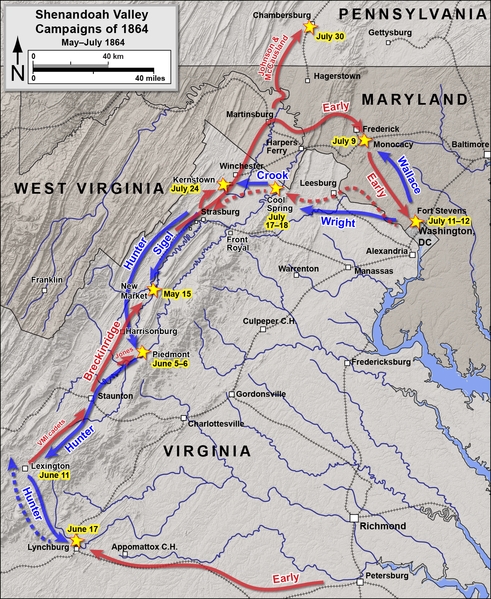
|
| Civil War Cool Spring History Map |
After the Battle of Fort Stevens on July 11, a Union column, consisting of the VI Corps and elements of
the XIX Corps under Maj. Gen. Horatio G. Wright, pursued Lt. Gen. Jubal Early's Army of the Valley as it withdrew from the
environs of Washington, D.C., through Loudoun County, Virginia. On July 15, Wright's force was joined by elements of Brig.
Gen. George Crook's command, which had accompanied Maj. Gen. David Hunter during his retreat through West Virginia following
the Battle of Lynchburg on June 18.
After two brief engagements in Loudoun County at Heaton's Crossroads (present-day Purcellville) and Woodgrove
on July 16, Early's main force crossed the Blue Ridge Mountains at Snickers Gap and established themselves around Berryville.
To cover his rear, Early left substantial rearguard forces at main river crossings of the Shenandoah River. On July 17, the
Union cavalry passed through Snickers Gap and unsuccessfully attempted to force passage of the river at Castleman's Ferry
(Snicker's Ford).
The following day, Gens. Crook and Wright arrived at Snickers Gap and determined to attack what they mistakenly
thought was a light picket line of Confederates along the river, left to cover Early's retreat up the Valley. Instead of allowing
his cavalry to cross the river and reconnoiter the Confederate positions to confirm this assumption, it was dispatched to
Ashby's Gap to attack Early's supply train which was traveling to the south of Early's main army. Wright then developed a
plan where a small Federal force would cross the river downstream from the main crossing at Castleman's Ferry and flank the
Confederate position. Gen. Crook assigned Col. Joseph Thoburn to this task.
| Civil War Battle of Cool Spring History |
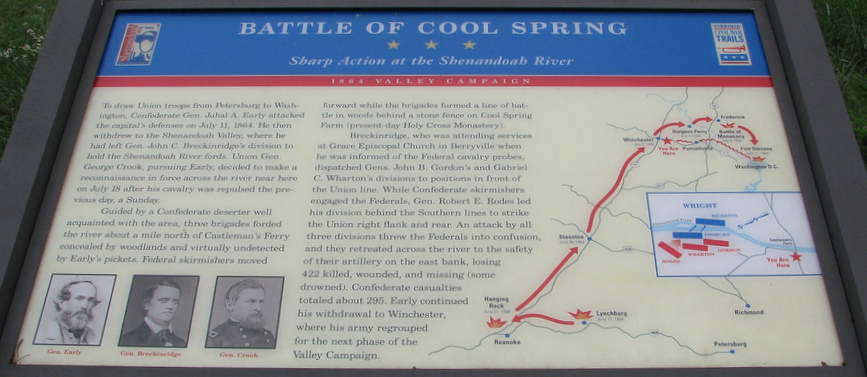
|
| The Battle of Cool Spring, Virginia, History |
| Battle of Cool Spring |

|
| Civil War Battle of Cool Spring Map |
Battle: At 3 p.m., Thoburn crossed the Shenandoah below
Castleman's Ferry, at Judge Richard Parker's Ford, quickly driving off a small force of Confederate pickets. The pickets quickly
alerted their commanders, Maj. Gens. John B. Gordon and John C. Breckinridge, of the Federal advance. Gordon responded by
moving a division to the vicinity of the ford, using a small ridge that lay between him and the Federals to screen his movements.
Breckinridge ordered Brig. Gen. Gabriel C. Wharton and Maj. Gen. Robert E. Rodes to the ford; they deployed along Gordon's
left flank, with Wharton forming the center. Wharton's sharpshooters quickly drove back Thoburn's skirmishers who occupied
a valley between the ridge on which the Confederates were lined and the high ground along the riverbank where the first of
two federal lines was formed in front of a stone fence. A reserve line was located on the low sunken bank of the river behind
the stone fence, well protected and concealed from the Confederates.
Around 6 p.m., Rodes attacked the main Federal position on the high ground
along its right flank. The Federal line turned to meet the attack and exposed its left flank to enfilading fire from Gordon
and Wharton. Given the exposed position and the inexperience of many of the men in the Federal ranks (many were so-called
"100-days men" who enlisted to man the fortifications around Washington and had not seen battle before), the line quickly
collapsed and Federals began streaming across the Shenandoah, jumping over the reserve line in the process. About the time
of the Federal retreat, Brig. Gen. James B. Ricketts arrived on the eastern bank of the river. Originally intended to reinforce
Thoburn, Gen. Wright demurred with Thoburn's line in full retreat. As Rodes's men pressed the attack they came to the stone
wall, whereupon the Federal reserve line opened up on the unsuspecting Confederates, driving them back towards the ridge.
Throughout the remainder of the evening, Rodes sent small brigade-level attacks at the Federal position on the river bank
but was unsuccessful in driving them across the river, because Thoburn was able to reinforce his right due to the lack of
pressure on his left by Gordon and Wharton. After sunset, Thoburn retired the rest of his force across the river.
| Cool Spring Historical Marker |
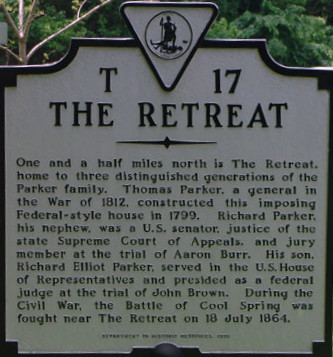
|
| Battle of Cool Spring Historical Marker |
| Clarke County, Virginia, Map |
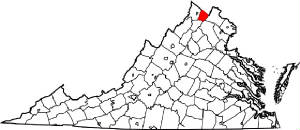
|
| Battle of Cool Spring Map |
Aftermath and Analysis: The Battle of Cool Spring,
also known as Castleman's Ferry, Island Ford, Parker's Ford, and Snicker's Ferry, was a battle in the American Civil War fought
July 17–18, 1864, in Clarke County, Virginia, as part of the Valley Campaigns of 1864. The battle was a Confederate
victory.
Wright had sent a small force against a well reinforced Confederate position
without the aid of cavalry because he mistakenly assumed it was only the pickets of Early's rearguard. Thoburn's force paid
dearly for the mistake. Still, Thoburn's judicious use of terrain and lack of coordination on the Confederate side allowed
Thoburn to stave off a full routing of his troops and thus was able to minimize his casualties. The following day both armies
remained in the same positions as the night before and engaged in little fighting. Gen. Hunter, however, took the initiative
and sent a force out from Harpers Ferry to pressure Early's position from the north, causing the Confederates to withdrawal
from Berryville the following day and setting in motion the Valley Campaigns of 1864. Advance to: The Battle of Cool Spring: Detailed History and Shenandoah Valley Campaigns: The Civil War Battles.
During the Civil War in the summer of 1864, also in Clarke County,
John S. Mosby, "the Gray Ghost" of the Confederacy, raided General Sheridan's supply train at Berryville. The Battle of
Berryville was fought on September 3, 1864.
(Sources and related reading below.)
Recommended
Reading: The
Shenandoah Valley Campaign of 1864 (McFarland & Company). Description: A
significant part of the Civil War was fought in the Shenandoah Valley of Virginia, especially in 1864. Books and articles
have been written about the fighting that took place there, but they generally cover only a small period of time and focus
on a particular battle or campaign. Continued below...
This work covers
the entire year of 1864 so that readers can clearly see how one event led to another in the Shenandoah Valley and turned once-peaceful
garden spots into gory battlefields. It tells the stories of the great leaders, ordinary men, innocent civilians, and armies
large and small taking part in battles at New Market, Chambersburg, Winchester, Fisher’s
Hill and Cedar Creek, but it primarily tells the stories of the soldiers, Union and Confederate,
who were willing to risk their lives for their beliefs. The author has made extensive use of memoirs, letters and reports
written by the soldiers of both sides who fought in the Shenandoah Valley in 1864.
Recommended
Reading: The
Shenandoah Valley Campaign of 1864 (Military Campaigns of the Civil War) (416 pages) (The University of North
Carolina Press). Description: The 1864 Shenandoah Valley Campaign
is generally regarded as one of the most important Civil War campaigns; it lasted more than four arduous months and claimed
more than 25,000 casualties. The massive armies of Generals Philip H. Sheridan and Jubal A. Early had contended for immense
stakes... Beyond the agricultural bounty and the boost in morale to be gained with its numerous battles, events in the Valley
would affect Abraham Lincoln's chances for reelection in November 1864. Continued below...
The eleven
essays in this volume reexamine common assumptions about the campaign, its major figures, and its significance. Taking advantage
of the most recent scholarship and a wide range of primary sources, contributors examine strategy and tactics, the performances
of key commanders on each side, the campaign's political repercussions, and the experiences of civilians caught in the path
of the armies. The authors do not always agree with one another, but, taken together, their essays highlight important connections
between the home front and the battlefield, as well as ways in which military affairs, civilian experiences, and politics
played off one another during the campaign.
Recommended
Reading: Stonewall in the Valley: Thomas J. Stonewall Jackson's Shenandoah Valley Campaign,
Spring 1862. Description: The Valley Campaign
conducted by Maj. Gen. Thomas J. "Stonewall" Jackson has long fascinated those interested in the American Civil War as well
as general students of military history, all of whom still question exactly what Jackson
did in the Shenandoah in 1862 and how he did it. Since Robert G. Tanner answered many questions in the first edition of Stonewall
in the Valley in 1976, he has continued to research the campaign. This edition offers new insights on the most significant
moments of Stonewall's Shenandoah triumph. Continued below…
About the Author:
Robert G. Tanner is a graduate of the Virginia Military Institute. Tanner is a native of Southern California, he now lives
and practices law in Atlanta, Georgia. He has studied and lectured
on the Shenandoah Valley Campaign for more than twenty-five years.
Recommended
Reading: The Shenandoah Valley Campaign of
1862, by Gary W. Gallagher. Description:
In eight new essays, contributors to this volume explore the Shenandoah Valley campaign, best known for its role in establishing
Thomas J. "Stonewall" Jackson's reputation as a Confederate hero. In early 1862, Union troops under George B. McClellan had
arrived within range of Richmond and threatened to take the
Confederate capital. Robert E. Lee ordered Jackson to march north through the Shenandoah
Valley, hoping to tie down Federal forces that might otherwise reinforce McClellan's troops. The strategy worked,
and for two months the Confederates evaded and harassed their Union pursuers. Jackson's
speed and audacity boosted plummeting Southern morale, and he emerged from the Valley as the Confederacy's greatest military
idol. Continued below…
Contributors
address questions of military leadership, strategy and tactics, the campaign's political and social impact, and the ways in
which participants' memories of events differed from what is revealed in the historical sources. In the process, they offer
valuable insights into one of the Confederacy's most famous generals, those who fought with him and against him, the campaign's
larger importance in the context of the war, and the complex relationship between history and memory. Contributors include
Jonathan M. Berkey, Keith S. Bohannon, Peter S. Carmichael, Gary W. Gallagher, A. Cash Koeniger, R. E. L. Krick, Robert K.
Krick, and William J. Miller. About the Author: Gary W. Gallagher is John L. Nau III Professor of History at the University
of Virginia. He is author, most recently, of Lee and His Army in Confederate
History.
Recommended
Reading: Shenandoah 1862: Stonewall Jackson's Valley Campaign, by Peter Cozzens (Civil War America) (Hardcover). Description: In the spring of 1862, Federal troops under
the command of General George B. McClellan launched what was to be a coordinated, two-pronged attack on Richmond in the hope of taking the Confederate capital and bringing a quick end to the Civil
War. The Confederate high command tasked Stonewall Jackson with diverting critical Union resources from this drive, a mission
Jackson fulfilled by repeatedly defeating much larger enemy forces. His victories elevated him to near iconic status in both
the North and the South and signaled a long war ahead. One of the most intriguing and storied episodes of the Civil War, the
Valley Campaign has heretofore only been related from the Confederate point of view. Continued below…
With Shenandoah
1862, Peter Cozzens dramatically and conclusively corrects this shortcoming, giving equal attention to both Union and Confederate perspectives.
Based on a multitude of primary sources, Cozzens's groundbreaking work offers new interpretations of the campaign and the
reasons for Jackson's success. Cozzens also demonstrates instances
in which the mythology that has come to shroud the campaign has masked errors on Jackson's
part. In addition, Shenandoah 1862 provides the first detailed appraisal of Union leadership in the Valley Campaign, with
some surprising conclusions. Moving seamlessly between tactical details and analysis of strategic significance, Cozzens presents
the first balanced, comprehensive account of a campaign that has long been romanticized but never fully understood. Includes
13 illustrations and 13 maps. About the Author: Peter Cozzens is an independent scholar and Foreign Service officer with the
U.S. Department of State. He is author or editor of nine highly acclaimed Civil War books, including The Darkest Days of the
War: The Battles of Iuka and Corinth (from the University
of North Carolina Press).
Recommended
Reading: Shenandoah Summer:
The 1864 Valley Campaign. Description:
Jubal A. Early’s disastrous battles in the Shenandoah Valley ultimately resulted in
his ignominious dismissal. But Early’s lesser-known summer campaign of 1864, between his raid on Washington and Phil
Sheridan’s renowned fall campaign, had a significant impact on the political and military landscape of the time. By
focusing on military tactics and battle history in uncovering the facts and events of these little-understood battles, Scott
C. Patchan offers a new perspective on Early’s contributions to the Confederate war effort—and to Union battle
plans and politicking. Patchan details the previously unexplored battles at Rutherford’s Farm and Kernstown (a pinnacle
of Confederate operations in the Shenandoah Valley) and examines the campaign’s influence
on President Lincoln’s reelection efforts. Continued below…
He also provides
insights into the personalities, careers, and roles in Shenandoah of Confederate General John C. Breckinridge, Union general
George Crook, and Union colonel James A. Mulligan, with his “fighting Irish” brigade from Chicago.
Finally, Patchan reconsiders the ever-colorful and controversial Early himself, whose importance in the Confederate military
pantheon this book at last makes clear. About the Author: Scott C. Patchan, a Civil War battlefield guide and historian, is
the author of Forgotten Fury: The Battle of Piedmont, Virginia, and a consultant and contributing writer for Shenandoah, 1862.
Review
"The author's
descriptions of the battles are very detailed, full or regimental level actions, and individual incidents. He bases the accounts
on commendable research in manuscript collections, newspapers, published memoirs and regimental histories, and secondary works.
The words of the participants, quoted often by the author, give the narrative an immediacy. . . . A very creditable account
of a neglected period."-Jeffry D. Wert, Civil War News (Jeffry D. Wert Civil War News 20070914)
"[Shenandoah
Summer] contains excellent diagrams and maps of every battle and is recommended reading for those who have a passion for books
on the Civil War."-Waterline (Waterline 20070831)
"The narrative
is interesting and readable, with chapters of a digestible length covering many of the battles of the campaign."-Curled Up
With a Good Book (Curled Up With a Good Book 20060815)
"Shenandoah
Summer provides readers with detailed combat action, colorful character portrayals, and sound strategic analysis. Patchan''s
book succeeds in reminding readers that there is still plenty to write about when it comes to the American Civil War."-John
Deppen, Blue & Grey Magazine (John Deppen Blue & Grey Magazine 20060508)
"Scott C. Patchan
has solidified his position as the leading authority of the 1864 Shenandoah Valley Campaign with his outstanding campaign
study, Shenandoah Summer. Mr. Patchan not only unearths this vital portion of the campaign, he has brought it back to life
with a crisp and suspenseful narrative. His impeccable scholarship, confident analyses, spellbinding battle scenes, and wonderful
character portraits will captivate even the most demanding readers. Shenandoah Summer is a must read for the Civil War aficionado
as well as for students and scholars of American military history."-Gary Ecelbarger, author of "We Are in for It!": The First
Battle of Kernstown, March 23, 1862 (Gary Ecelbarger 20060903)
"Scott Patchan
has given us a definitive account of the 1864 Valley Campaign. In clear prose and vivid detail, he weaves a spellbinding narrative
that bristles with detail but never loses sight of the big picture. This is a campaign narrative of the first order."-Gordon
C. Rhea, author of The Battle of the Wilderness: May 5-6, 1864 (Gordon C. Rhea )
"[Scott Patchan]
is a `boots-on-the-ground' historian, who works not just in archives but also in the sun and the rain and tall grass. Patchan's
mastery of the topography and the battlefields of the Valley is what sets him apart and, together with his deep research,
gives his analysis of the campaign an unimpeachable authority."-William J. Miller, author of Mapping for Stonewall and Great
Maps of the Civil War (William J. Miller)
Try the Search Engine for Related Studies: Battle of Cool Spring Civil War Virginia History Battlefield
Map Confederate Army Union, Battle of Snicker’s Ferry, Details Summary Pictures Photographs, Historical marker Maps,
Washington DC Civil War
Sources: National Park Service; Official Records of the Union and Confederate
Armies; Patchan, Scott C. Shenandoah Summer: The 1864 Valley Campaign. Lincoln: University of Nebraska Press, 2007. ISBN 978-0-8032-3754-4;
Salmon, John S. The Official Virginia Civil War Battlefield Guide. Mechanicsburg, PA: Stackpole Books, 2001. ISBN 0-8117-2868-4.
|

